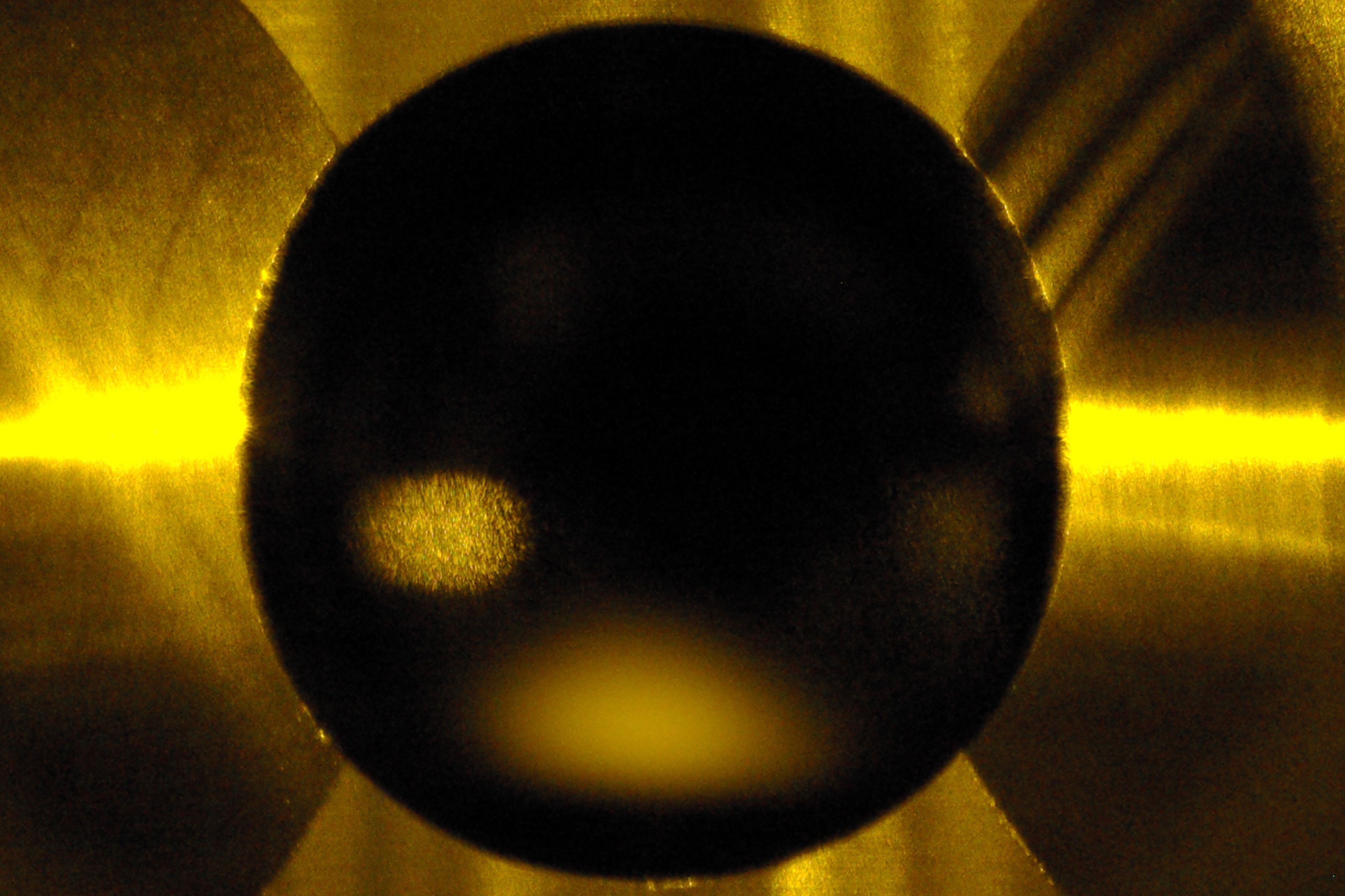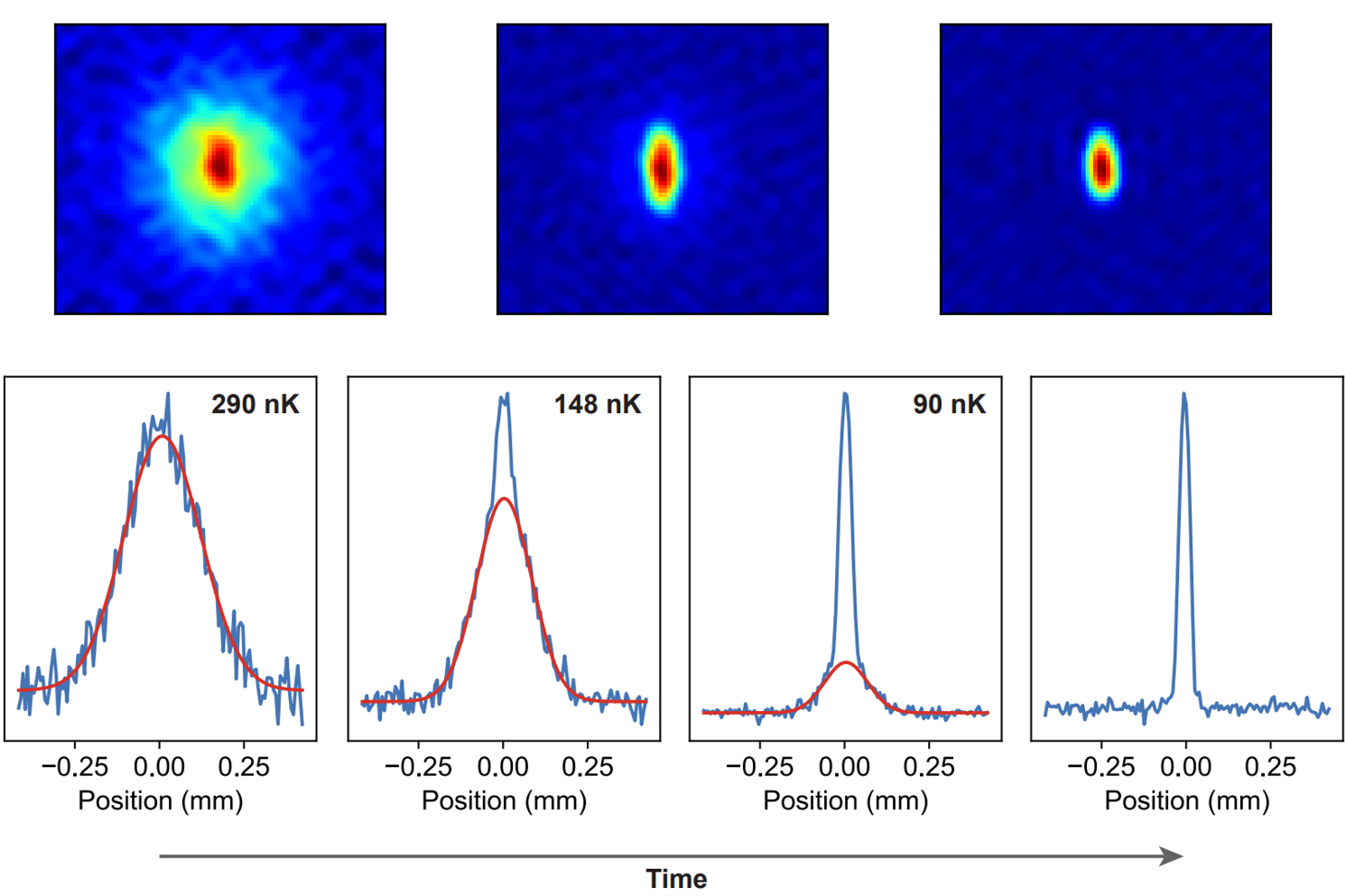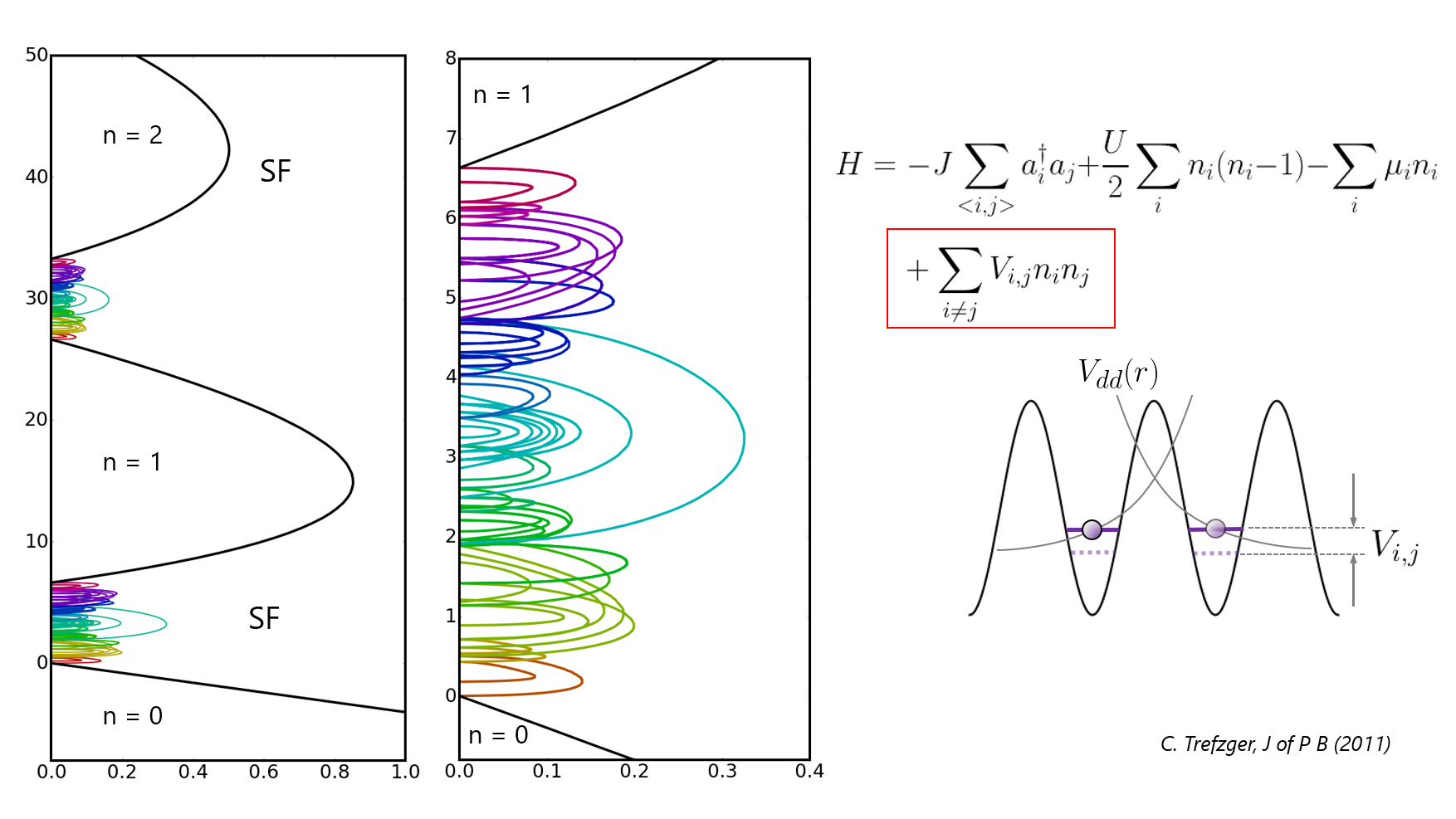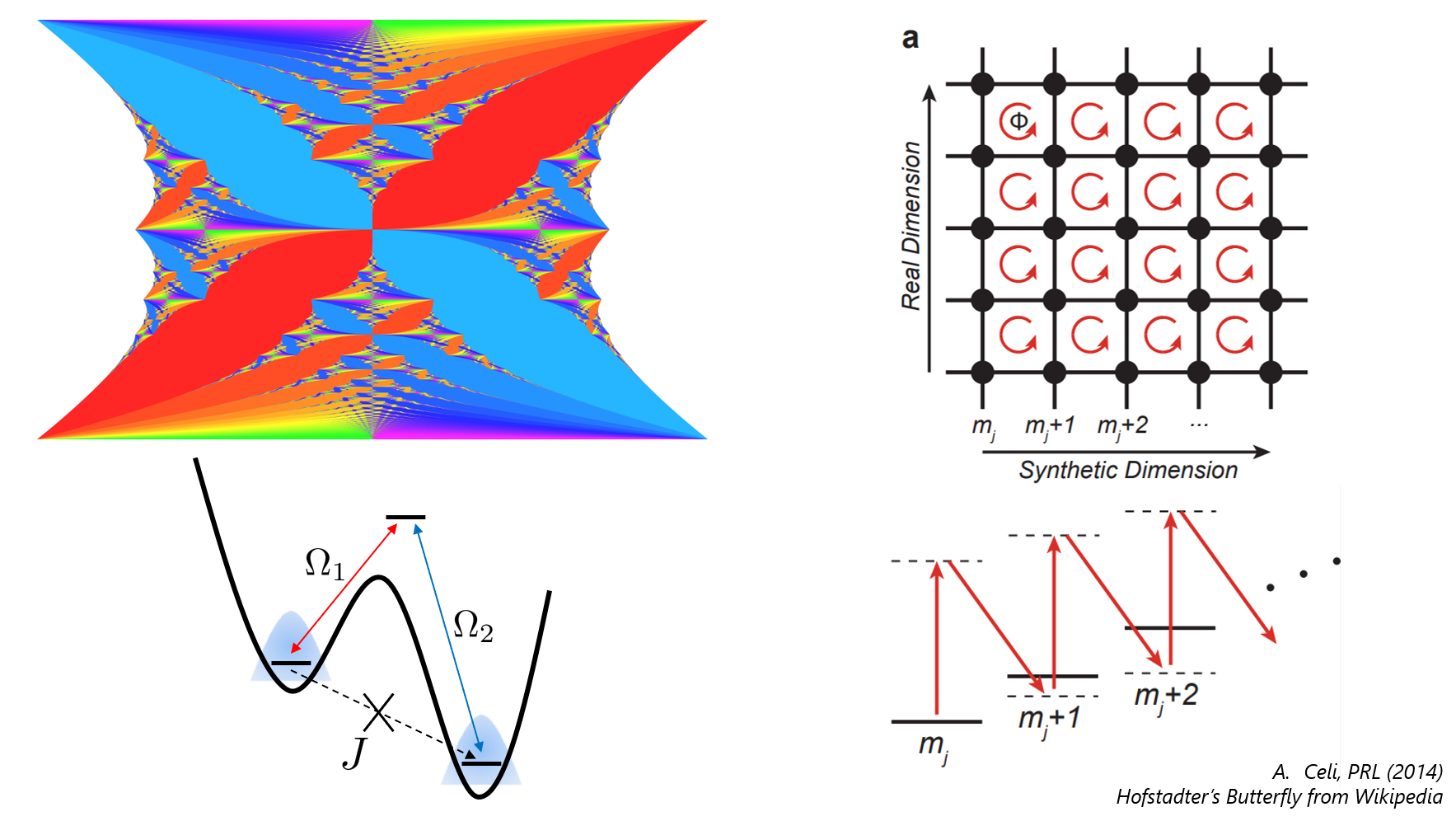Erbium Lab
Postdocs
Graduate Students
Former Group Members
Undergraduate (2023-2025)
Graduate Student (2019-2025)
Undergraduate (2022-2024)
Postdoc (2021-2023)
Visiting Student (2020-2021)
Graduate Student (2014-2020)
Graduate Student (2018-2021)
Graduate Student (2014-2021)
Graduate Student (2014-2019)
Undergraduate (2017-2018)
Postdoc (2014-2017)
Erbium offers an exciting opportunity to extend previous work in single-site imaging of quantum gases. Being highly dipolar, Erbium atoms interact via the long-range and anisotropic dipole force which gives rise to new emergent phenomena that do not arise in systems with only short-range interactions. The rich electronic structure of Erbium contains narrow transitions that can be used to create ultra-cold clouds directly via laser cooling. On the other hand, the broad transitions permit the implementation of ultra-fast imaging schemes. Since Erbium has multiple isotopes, there are various possibilities for studying lattice physics with either bosonic or fermionic statistics. With an erbium quantum gas microscope, we plan on studying aspects of magnetism, spin-orbit coupling, and novel phases of matter.
Technologies
A 2D tunable ‘accordion’ lattice is important for having strong dipolar interactions at short lattice spacings and near-perfect imaging fidelities at longer lattice spacings. Our approach uses an interferometrically aligned beamsplitter to create a pair of lattice beams whose phase difference remains constant across its entire aperture. We move the input beam with a galvanometer that changes the beam height without altering its angle. Together, the galvo and beamsplitter allow for the creation of a lattice whose spacing can be changed significantly without any fringe shift.
Progress
We generate a BEC of Erbium atoms with high condensate fraction in an optical dipole trap loaded from a narrow line magneto-optical trap. Thanks to fast evaporative cooling and narrow lines, experimental cycle times are significantly lower than other quantum gas microscopes.
Outlook
The Erbium experiment is well-equipped to study Fermionic, Bosonic, and dipolar physics. Site resolved imaging of dipoles on a lattice combined with long coherence times allows us to study Hubbard model physics enriched by long-range and anisotropic dipolar interactions. Synthetic gauge field physics is another exciting avenue for future work, having narrow transitions to generate Raman couplings and the advantage of low heating rates.
Exploring confinement transitions in \(\mathrm{Z}_2\) lattice gauge theories with dipolar atoms beyond one dimension
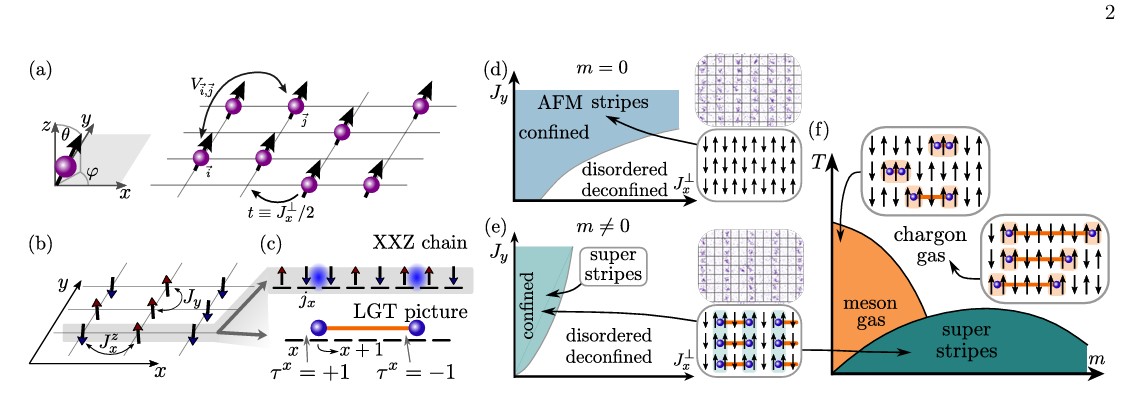
Confinement of particles into bound states is a phenomenon spanning from high-energy to condensed matter physics, which can be studied in the framework of lattice gauge theories (LGTs). Achieving a comprehensive understanding of confinement continues to pose a major challenge, in particular at finite matter density and in the presence of strong quantum fluctuations. State-of-the-art quantum simulators constitute a promising platform to address this problem. Here we study confinement in coupled chains of \(Z_2\) LGTs coupled to matter fields, that can be mapped to a mixed-dimensional (mixD) XXZ model. We perform large-scale numerical matrix-product state calculations to obtain the phase diagram of this model, in which we uncover striped phases formed by the \(Z_2\) charges that can be melted at finite temperature or by increasing the tunneling rate. To explore this setting experimentally, we use our quantum simulator constituted by erbium atoms with dipolar interactions in a quantum gas microscope, and observe the predicted melting of a stripe phase by increasing the particle tunneling rate. Our explorative experimental studies of thermal deconfinement of \(Z_2\) charges motivate our further theoretical study of the mixD \(Z_2\) LGT, in which we predict a confined meson gas at finite temperature and low magnetization where thermal fluctuations destroy stripes but enable spontaneous commensurate spin order. Overall, we demonstrate that our platform can be used to study confinement in \(Z_2\) LGTs coupled to matter fields, including long-range interactions and beyond one dimension, paving the way for future research of confinement in the quantum many-body regime.
Topological phase transitions and mixed state order in a Hubbard quantum simulator
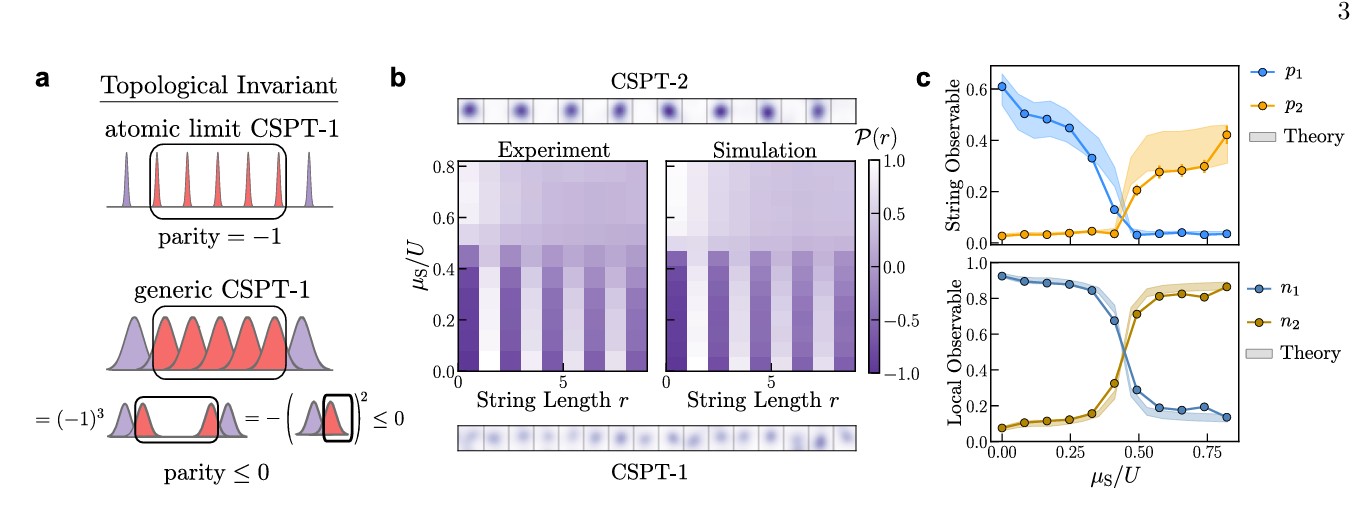
Topological phase transitions challenge conventional paradigms in many-body physics by separating phases that are locally indistinguishable yet globally distinct. Using a quantum simulator of interacting erbium atoms in an optical lattice, we observe such a transition between one-dimensional crystalline symmetry-protected topological phases (CSPTs). We detect the critical point through non-local string order parameters and reveal its connection to the transition predicted between the Mott and Haldane insulators. Moreover, we demonstrate a striking property: stacking two identical systems eliminates the transition, confirming the predicted group structure and invertibility of SPTs. Finally, while introducing symmetry-breaking disorder also removes the transition, disorder averaging restores it. Consequently, the adjacent phases realize a form of mixed-state quantum order wherein the criticality between them depends on the observer’s information. Our results demonstrate how topology and information influence quantum phase transitions, opening the doors to probing novel critical phenomena in programmable quantum matter.
Fast single atom imaging for optical lattice arrays
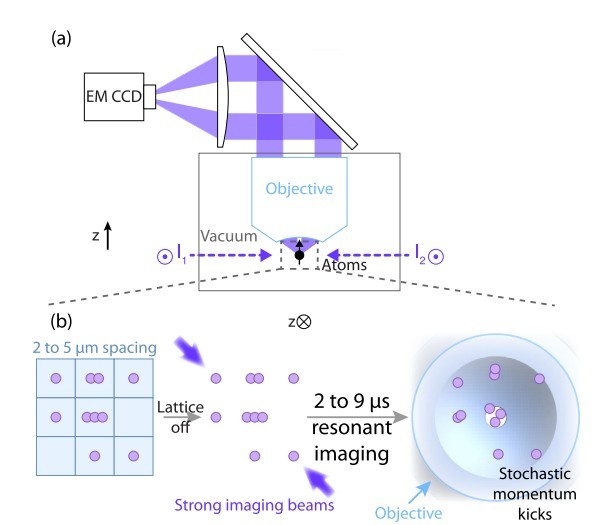
High-resolution fluorescence imaging of ultracold atoms and molecules is paramount to performing quantum simulation and computation in optical lattices and tweezers. Imaging durations in these experiments typically range from a millisecond to a second, significantly limiting the cycle time. In this work, we present fast, 2.4 μs single-atom imaging in lattices, with 99.4% fidelity - pushing the readout duration of neutral atom quantum platforms to be close to that of superconducting qubit platforms. Additionally, we thoroughly study the performance of accordion lattices. We also demonstrate number-resolved imaging without parity projection, which will facilitate experiments such as the exploration of high-filling phases in the extended Bose-Hubbard models, multi-band or SU(N) Fermi-Hubbard models, and quantum link models.
Spin Squeezing with Magnetic Dipoles
 Entanglement can improve the measurement precision of quantum sensors beyond the shot noise limit. Neutral atoms, the basis of some of the most precise and accurate optical clocks and interferometers, do not naturally exhibit all-to-all interactions that are traditionally used to generate such entangled states. Instead, we take advantage of the magnetic dipole-dipole interaction native to most neutral atoms to realize spin-squeezed states. We achieve 7.1 dB of metrologically useful squeezing using the finite-range spin exchange interactions in an erbium quantum gas microscope. We further propose and demonstrate that introducing atomic motion protects the spin sector coherence at low fillings, significantly improving the achievable spin squeezing in a 2D dipolar system. This work’s protocol can be implemented with most neutral atoms, opening the door to quantum-enhanced metrology in other itinerant dipolar systems, such as molecules or optical lattice clocks, and serves as a novel method for studying itinerant quantum magnetism with long-range interactions.
Entanglement can improve the measurement precision of quantum sensors beyond the shot noise limit. Neutral atoms, the basis of some of the most precise and accurate optical clocks and interferometers, do not naturally exhibit all-to-all interactions that are traditionally used to generate such entangled states. Instead, we take advantage of the magnetic dipole-dipole interaction native to most neutral atoms to realize spin-squeezed states. We achieve 7.1 dB of metrologically useful squeezing using the finite-range spin exchange interactions in an erbium quantum gas microscope. We further propose and demonstrate that introducing atomic motion protects the spin sector coherence at low fillings, significantly improving the achievable spin squeezing in a 2D dipolar system. This work’s protocol can be implemented with most neutral atoms, opening the door to quantum-enhanced metrology in other itinerant dipolar systems, such as molecules or optical lattice clocks, and serves as a novel method for studying itinerant quantum magnetism with long-range interactions.
Dipolar quantum solids emerging in a Hubbard quantum simulator
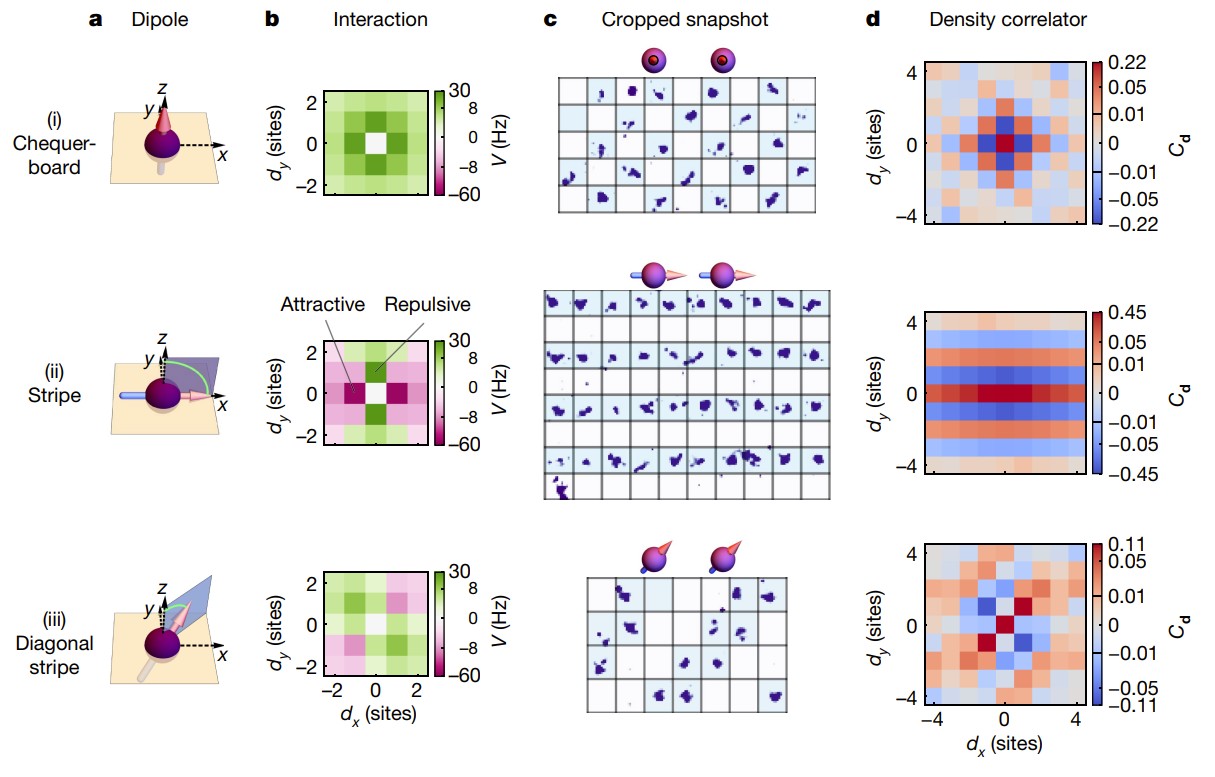 In quantum mechanical many-body systems, long-range and anisotropic interactions promote rich spatial structure and can lead to quantum frustration, giving rise to a wealth of complex, strongly correlated quantum phases. Long-range interactions play an important role in nature; however, quantum simulations of lattice systems have largely not been able to realize such interactions. A wide range of efforts are underway to explore long-range interacting lattice systems using polar molecules, Rydberg atoms, optical cavities, and magnetic atoms. Here, we realize novel quantum phases in a strongly correlated lattice system with long-range dipolar interactions using ultracold magnetic erbium atoms. As we tune the dipolar interaction to be the dominant energy scale in our system, we observe quantum phase transitions from a superfluid into dipolar quantum solids, which we directly detect using quantum gas microscopy. Controlling the interaction anisotropy by orienting the dipoles enables us to realize a variety of stripe ordered states. Furthermore, by transitioning non-adiabatically through the strongly correlated regime, we observe the emergence of a range of metastable stripe-ordered states. This work demonstrates that novel strongly correlated quantum phases can be realized using long-range dipolar interaction in optical lattices, opening the door to quantum simulations of a wide range of lattice models with long-range and anisotropic interactions.
In quantum mechanical many-body systems, long-range and anisotropic interactions promote rich spatial structure and can lead to quantum frustration, giving rise to a wealth of complex, strongly correlated quantum phases. Long-range interactions play an important role in nature; however, quantum simulations of lattice systems have largely not been able to realize such interactions. A wide range of efforts are underway to explore long-range interacting lattice systems using polar molecules, Rydberg atoms, optical cavities, and magnetic atoms. Here, we realize novel quantum phases in a strongly correlated lattice system with long-range dipolar interactions using ultracold magnetic erbium atoms. As we tune the dipolar interaction to be the dominant energy scale in our system, we observe quantum phase transitions from a superfluid into dipolar quantum solids, which we directly detect using quantum gas microscopy. Controlling the interaction anisotropy by orienting the dipoles enables us to realize a variety of stripe ordered states. Furthermore, by transitioning non-adiabatically through the strongly correlated regime, we observe the emergence of a range of metastable stripe-ordered states. This work demonstrates that novel strongly correlated quantum phases can be realized using long-range dipolar interaction in optical lattices, opening the door to quantum simulations of a wide range of lattice models with long-range and anisotropic interactions.


